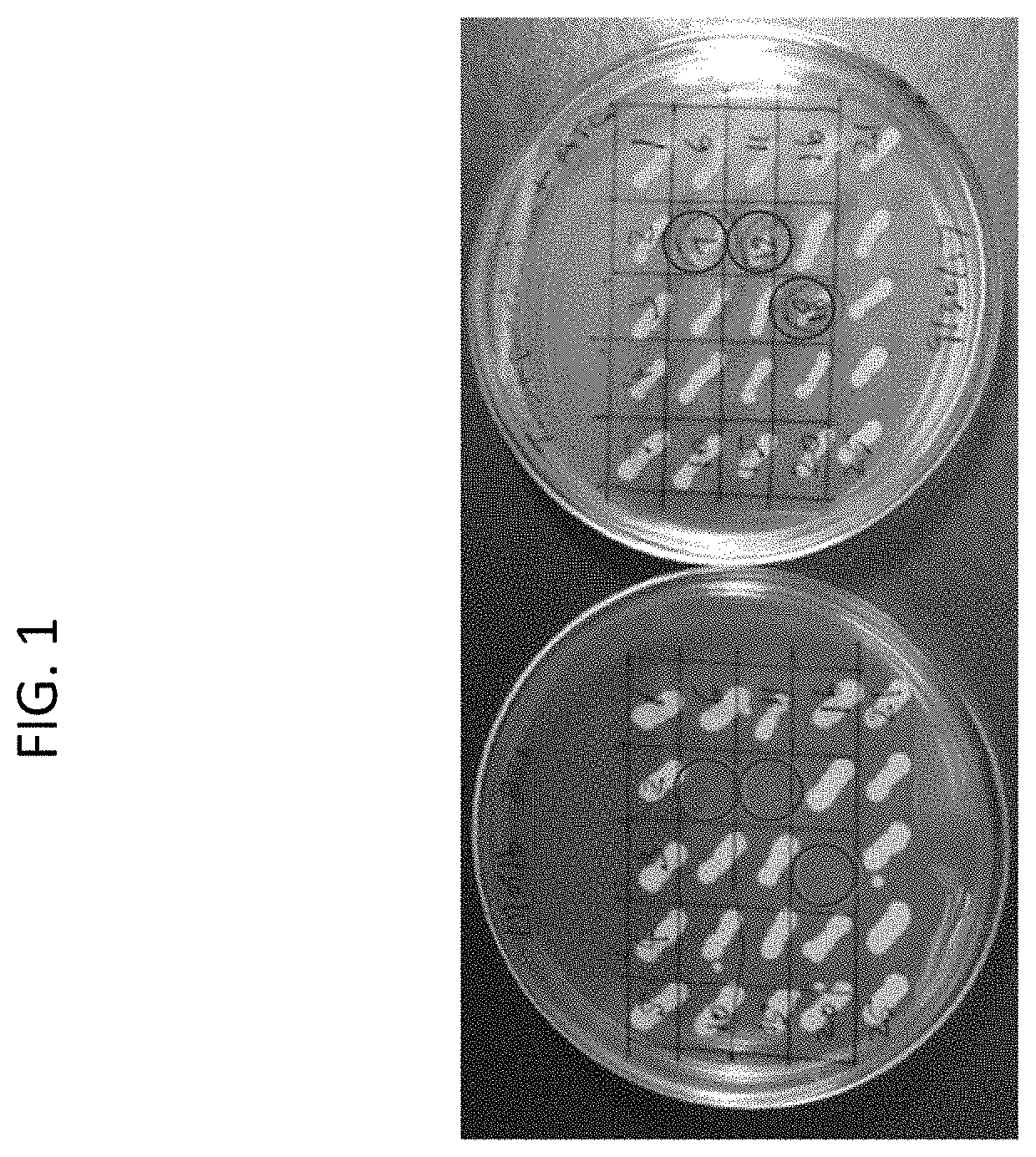Auxotrophic strains of staphylococcus bacterium
a technology of staphylococcus and i>bacterium, which is applied in the direction of racemaces/epimerases, transferases, and bacteria-based processes, etc. it can solve the problems of undesirable use of antibiotics, non-natural amino acids, and often inability to find antibiotics with such selectivity
- Summary
- Abstract
- Description
- Claims
- Application Information
AI Technical Summary
Problems solved by technology
Method used
Image
Examples
example 1
r Deletion of SE1423 (D-Alanine Aminotransferase)
[0062]The methods used to make SE1423 knockout (KO) are described briefly as follows. First, a SE1423 KO plasmid was made using pJB38 (Boss et al., 2013).
[0063]Primers
[0064]Based on genome sequence of S. epidermidis strain 12228, oligonucleotide primers were designed for PCR to develop a SE1423 knockout (KO) vector. Primer sequences, their specific uses and PCR product sizes are listed in Table 1 as shown below.
[0065]
TABLE 1Primers for SE1423 KnockoutPrimerSequence (5′ to 3′)Application1423-5FatgcgaattcATGAGCGATACTTATTTGAATCAmplification of 5′(EcoRI)flanking region of1423-5RctatgcgattgaatatacttttcCTTAGCATCCTCTTCATTAACSE1423 (0.5 Kb)1423-3FgttaatgaagaggatgctaaggaAAAGTATATTCAATCGCATAmplification of 3′AGflanking region of1423-3RagctgtcgacAGCAGCATACCAATGTCAATCSE1423 (1.0 Kb)(SalI)1423-FCATACGAAGATCGAGGCTACAmplification of a1423-RGTACCAACTTGTCCGTCTTGpartial SE1423 (0.7Kb)JB-Cm-FTTGATTTAGACAATTGGAAGAGTo amplify part ofJB-Cm-RAAGTACAGTCGGCAT...
example 2
n of Triple Knockout Strains (SEΔalr1 Δalr2Δdat)
[0067]pJB-1423KO plasmid isolated from Gm2163 was transformed into competent cells of S. epidermidis strain (SEΔalr1Δalr2) using plates of TAS+chloramphenicol (10 μg / mL). The presence of the pJB-1423KO plasmid in transformants was confirmed by detecting the PCR product of 1.5 Kb using primers 1423-5F (EcoRI) and 1423-3R (SalI). In all 26 clones tested, PCR product of 1.5 Kb was observed, while a PCR product of 2.3 Kb was observed in a reaction containing cell lysate from the SE host cells. Cells of two confirmed clones were streaked on fresh plates of TSA+Cm (10 μg / mL)+D-alanine (40 μg / mL). Plates were incubated at 43° C. for 24 hr for plasmid integration via homologous recombination. Isolated colonies were streaked again for purification at 43° C. Four isolated colonies were inoculated into 50 mL TSB+D-alanine (40 μg / mL) in a 250-mL baffled shake flask in order to loop out the plasmid backbone via a second round of homologous recombin...
example 3
D-Alanine Auxotrophy in the Triple Knockout Strains (SEΔalr1Δalr2Δdat)
[0068]A total of 25 isolated colonies from the TSA+ATC+DA plates were patched onto TAS plates and onto TAS+ATC+DA plates. Plates were incubated at 30° C. overnight. All clones grew well on the D-alanine supplemented plate (TSA+ATC+DA). As shown in FIG. 1, three clones (#7, #12 and #18) failed to grow on TSA without D-alanine supplementation, indicating D-alanine auxotrophy. The auxotrophic phenotype was observed again when cells from patches on the TSA+ATC+DA plate were patched again on TSA plates. Note that it was expected that some clones from the TSA+ATC+DA plates would retain the wild type SE1423 locus since the second round of homologous recombination could result in the removal of the plasmid backbone without knocking out SE1423.
[0069]The clones that were D-alanine auxotrophs were further analyzed. When these 1423KO SE clones were patched onto TSA+Cm (10 μg / mL), they did not grow, indicating removal during t...
PUM
| Property | Measurement | Unit |
|---|---|---|
| pH | aaaaa | aaaaa |
| concentration | aaaaa | aaaaa |
| size | aaaaa | aaaaa |
Abstract
Description
Claims
Application Information
 Login to View More
Login to View More - R&D
- Intellectual Property
- Life Sciences
- Materials
- Tech Scout
- Unparalleled Data Quality
- Higher Quality Content
- 60% Fewer Hallucinations
Browse by: Latest US Patents, China's latest patents, Technical Efficacy Thesaurus, Application Domain, Technology Topic, Popular Technical Reports.
© 2025 PatSnap. All rights reserved.Legal|Privacy policy|Modern Slavery Act Transparency Statement|Sitemap|About US| Contact US: help@patsnap.com



